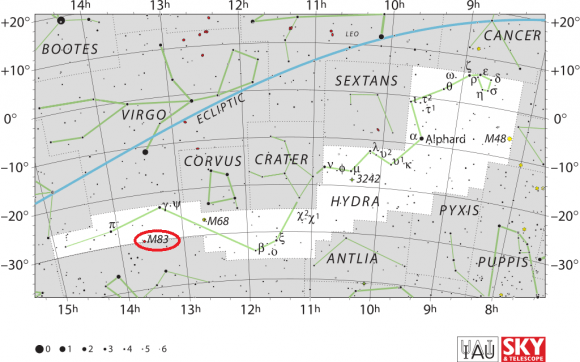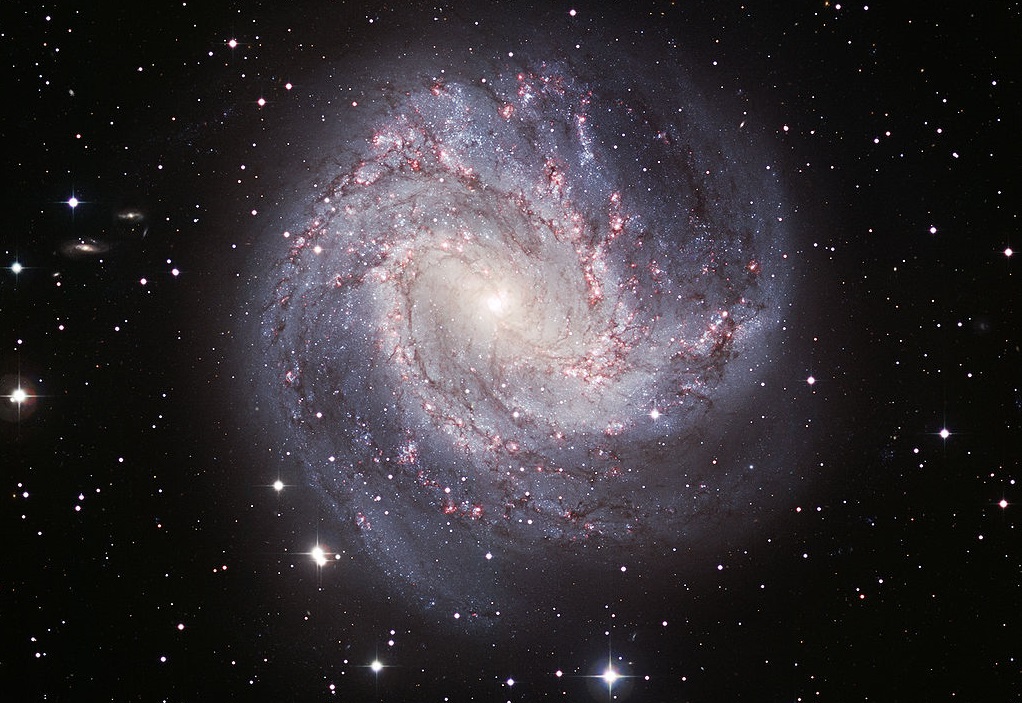Welcome back to Messier Monday! Today, we continue in our tribute to our dear friend, Tammy Plotner, by looking at the Southern Pinwheel Galaxy – also known as Messier 83!
During the 18th century, famed French astronomer Charles Messier noticed the presence of several “nebulous objects” while surveying the night sky. Originally mistaking these objects for comets, he began to catalog them so that others would not make the same mistake. Today, the resulting list (known as the Messier Catalog) includes over 100 objects and is one of the most influential catalogs of Deep Space Objects.
One of these objects is the Southern Pinwheel Galaxy (aka. Messier 83), a barred spiral galaxy located 15.21 million light years from Earth in the southern constellation Hydra. With a spatial diameter of about 55,000 light years, or roughly half the size of the Milky Way, M83 is one of the nearest and brightest barred spirals in the sky.
Description:
M83 is classified as somewhere between an intermediate and normal barred spiral galaxy with well formed spiral arms, dust lanes, a central bar and strong nucleus… Yet loaded with faint features. As David Malin (et al.) indicated in a 1997 study:
“Here we present examples of gas-rich galaxies without obvious interactions or companions that nonetheless show evidence of interaction. A nearby example is NGC 253, in the Sculptor group. The extent of the optical halo of this galaxy is much greater than that of the neutral hydrogen envelope detected by Koribalski et al. (1995), and it also extends well beyond the fields where Hawthorn has detected diffuse H-alpha emission (unpublished). The low surface brightness envelope is devoid of fine detail and is unusual in not being strongly truncated, as is the case for most spirals. However, it also shows a distinct, asymmetrical extension in the southern half of the galaxy. This is difficult understand, since NGC 253 is not obviously interacting with other members of the Sculptor group, and no other structures in the disk of the galaxy, or in the HI velocity profile, suggest any kind of external disturbance.”
But it is what’s happening internally toward the nucleus that bears great study. As Debra Elmegreene (et al) indicated in a 2007 study:
“Our (J-K) color observations of the central regions of the starburst galaxy M83 reveal a double circumnuclear ring. The main dust lanes spiral into the outer nuclear ring at a radius of 150 pc. The two rings may coincide with two inner Lindblad resonances. The main hot spots occur in an arc that is between the rings. A dust bar that is offset 90° from the primary stellar bar connects the outer nuclear ring to the inner nuclear ring at a radius of 50 pc and may provide the path for gas to flow to the central starburst.”
And it is the central starburst activity that excites. As S. Ryder (et al) said in their 2004 study:
“The circumnuclear starburst in NGC 5236 (M 83) has been studied photometrically by Harris et al. (2001) using HST/WFPC2 images in the broad-band near-UV and optical, as well as narrow-band Ha and Hb to derive colors and line equivalent widths for 45 clusters. Despite the excellent spatial resolution of these observations, optical photometric analyses such as this suffer from: (i) patchy (and not easily quantifiable) dust extinction; (ii) the fact that the reddening vector parallels the evolutionary tracks in a two-color diagram; and (iii) selection effects, which tend to exclude the very youngest (t < 5 Myr) clusters which have strong emission lines, but only a weak stellar continuum. Additionally, it is not possible to distinguish an instantaneous burst of star formation from a constant star formation rate, on the basis of broad-band colors alone.”
One of Messier 83’s most unusual qualities is the remarkable number of supernovae events recorded in just the last century. As Christopher Stockdale (et al) indicated in a 2006 study:
“We report the results of 15 years of radio observations of the six historical supernovae (SNe) in M83 using the Very Large Array. We note the near-linear decline in radio emission from SN 1957D, a Type II SN, which remains a nonthermal radio emitter. The measured flux densities from SNe 1923A and 1950B have flattened as they begin to fade below detectable limits; they are also Type II SNe. The luminosities for these three SNe are comparable with the radio luminosities of other decades-old SNe at similar epochs. SNe 1945B, 1968L, and 1983N were not detected in the most recent observations, and these nondetections are consistent with previous studies. We report the X-ray nondetections of all six historical SNe using the Chandra X-Ray Observatory, consistent with previous X-ray searches of other decades-old SNe and low inferred mass-loss rates of the progenitors.”
History of Observation:
M83 was discovered by Abbe Nicholas Louis de la Caille at the Cape of Good Hope on February 23, 1752 and was the first outside our Local Group to be cataloged. Despite its very low position for Paris, it was next cataloged by Charles Messier on February 17, 1781 who said:
“Nebula without star, near the head of Centaurus: it appears as a faint and even glow, but it is difficult to see in the telescope, as the least light to illuminate the micrometer wires makes it disappear. One is only able with the greatest concentration to see it at all.”
Although it would be detected by Sir William Herchel, it was his son John who would later write from the Cape of Good Hope:
“Very bright; very large; suddenly brighter toward the middle to a centre resembling a star of 9 m, diameter 8″, of a resolvable character like a globular cluster, surrounded by an immensely large, extremely dilute almost equable light 7′ or 8′ diam, somewhat oval, and passing with an excessive suddenness into the central light.”
Locating Messier 83:
Because of Messier 83’s low southern position, it is somewhat difficult to find in the northern hemisphere, despite it’s magniude and size. Start by indentifying Gamma or Pi Hydrae. From Gamma it is about a fistwidth northwest from Pi about a fistwidth southwest. If you are in the southern hemisphere, locate Iota and Theta Centauri and simply starhop 1, 2, 3, 4, 5 to M83. From the north it will require at least a 3-4″ telescope and dark skies, while southerns can spot it easily with small binoculars.

Wishing you luck in finding it!
Object Name: Messier 83
Alternative Designations: M83, NGC 5236, Southern Pinwheel Galacy
Object Type: SABc Spiral Galaxy
Constellation: Hydra
Right Ascension: 13 : 37.0 (h:m)
Declination: -29 : 52 (deg:m)
Distance: 15000 (kly)
Visual Brightness: 7.6 (mag)
Apparent Dimension: 11X10 (arc min)
We have written many interesting articles about Messier Objects and globular clusters here at Universe Today. Here’s Tammy Plotner’s Introduction to the Messier Objects, M1 – The Crab Nebula, Observing Spotlight – Whatever Happened to Messier 71?, and David Dickison’s articles on the 2013 and 2014 Messier Marathons.
Be sure to check out our complete Messier Catalog. And for more information, check out the SEDS Messier Database.
Sources:


Man…. she sure knew her stuff when it came to Messier (and probably a great many other things).